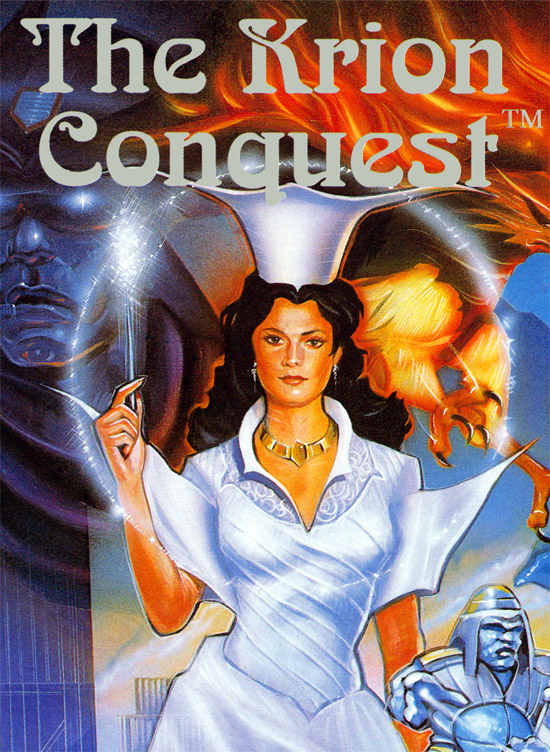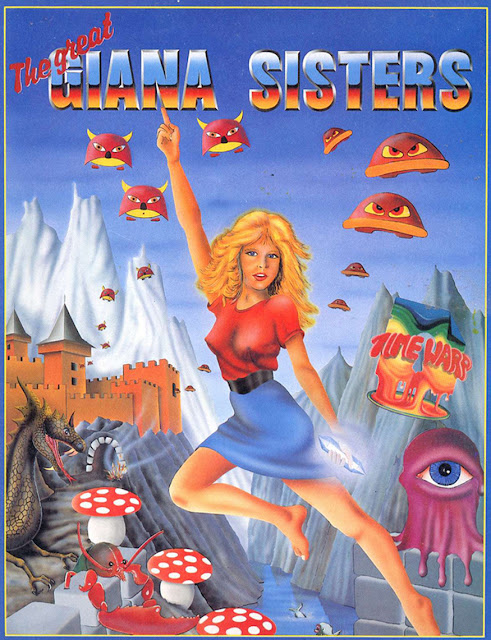Back in the early days of home console video games, the name Vic Tokai didn’t exactly rank alongside the Segas and Nintendos. It wasn’t even among the Data Easts. But until it wasn’t anymore, this company was in the mix, releasing games that at the very least had memorable names — among them, From the Legend of Balubalouk, Block Gal, The Gene Machine, Kid Kool and the Quest for the Seven Wonder Herbs, King Salmon: The Big Catch, Daedalian Opus, and the game that Scott Pilgrim vs. the World gave a second life, Clash at Demonhead. And for the purposes of this post, it’s also notable that Vic Tokai developed a game called The Krion Conquest.
If you know much about the also-rans of the NES era, you may know that Krion has a reputation for being a shameless Mega Man rip-off. See for yourself:
From the background music to the robo-enemies to the fact that the witchy main character’s sprite color changes according to what special weapon she’s using, the game seems like a hacked Mega Man title. Steal from the best, I guess. I can say one good thing about The Krion Conquest, though: In translating the game for a Western audience, Vic Tokai chose to keep the lead character female. This is not always how games make their way out of Japan, importantly: A Sega Mega Drive title released that same year by Vic Tokai transformed from Magical Hat Flying Turbo Adventure, which starred a fellow wearing a turban, to DecapAttack, which stars a mummy named Chuck D. Head who, naturally, kills enemies by chucking his head at them because that’s more American. In the end, Americans got a wholly reformated game with new levels and completely altered graphics. It’s a different case with Krion, which ditched the original Japanese version’s intra-level cut scenes but at the very least kept the witch — Francesca in the American version, Doropie in the original — as the hero. In fact, not only did the game retain Francesca, but it embraced her femininity in a big way.
Check out the full version of the box art for the American release:
She’s pretty boss — thoroughly feminine with a touch of Glinda the Good Witch, yes, but not pink, not covered in bows and ribbons and not showing so much skin that she’s imperiling her personal safety. (Though identical onscreen, she’s far less cutesy here than she looked in the Japanese release. She also looks like Catherine Zeta-Jones. That is neither here not there.) I’m struggling to think of another female lead character in an NES-era video game who got the main spot on the box art and isn’t princessed out, be-bowed (like Ms. Pac-Man, whose gender basically hinges on that one accessory onscreen), violating the basic rules of armor (Arkista’s Ring, I’m looking at you) or just wholly disguised (looking at the Metroid box art, not even the most perceptive of us would have guessed Samus was a spacewoman and not a spaceman).
I’m now spinning my wheels in an effort to think of other female characters of that early home console era that got this treatment, and I can only come up with one that even comes close: Giana from The Great Giana Sisters, who shows up on the box art for the Commodore 64 release.
She has a mighty, Supergirl-ish vibe, sure, but now that I look at in large format, I see she’s got some damn mighty nipples, too — visible straight on and in profile! Which is maybe less so with the progressive. It’s worth mentioning that Great Giana Sisters is only famous for being a shameless rip-off of Super Mario Bros., though it has endured where Krion has vanished. I suppose both games attempted to re-create the success of more popular series by stealing the play mechanics and then slapping some female characters into the protagonist roles in order to emphasize how different they were, so it’s maybe not surprising that the marketing emphasized the heroines. Still, I’d feel better if I could think of a single example from a wholly original series. I can’t. Today, we don’t remember The Krion Conquest for being much other than a mediocre Mega Man wannabe. That’s too bad. For one, it actually innovated the Mega Man play mechanics by, for example, enabling Francesca to charge up her projectile to unleash a more powerful attack. Mega Man 4, released nearly a year after Krion, incorporated the idea, so clearly Krion wasn’t entirely without merits. I’m more concerned with the gender politics here, of course, and I like that Vic Tokai elected to create a female main character and then run with it — and “do her right,” so to speak.
The Wikipedia page for Krion claims that even in the planning stages at Vic Tokai’s Japanese office, the decision caused controversy. I can see why. But to me — back then, a kid whose Super Mario Bros. 2 default was the princess and whose Gauntlet default was the valkyrie — this box art grabbed my attention enough that I stopped and said “This is the one.” That was the point, I think, and at the moment, that seemed like enough.
| via |
(A concluding side note: Surprisingly, there’s no Wikipedia list of video games with female protagonists. And a Google search only turns up sloppy attempts that aren’t organized chronologically ordered. Of all that I found, Giant Bomb’s list is the best, but it’s far from complete. You’d think that would be a thing by now, right?)
Gender and video games, previously:




No comments:
Post a Comment